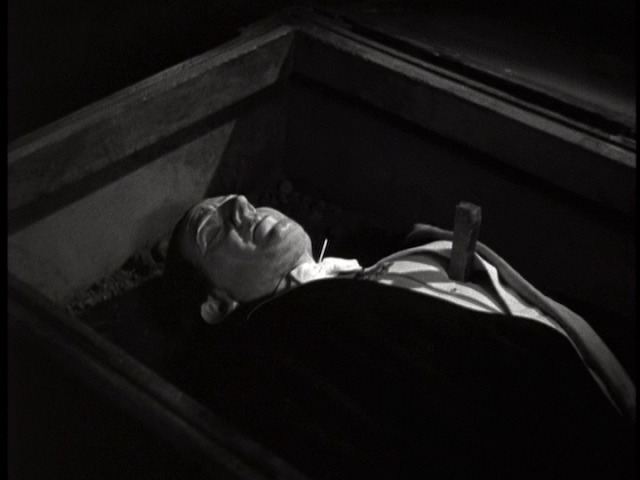1943's Return of the Vampire was a spiritual sequel to Tod Browning's Dracula, bringing Bela Lugosi back to play a legally distinct version of the vampire who made him famous. Dracula's Daughter (1936), on the other hand, is the direct sequel to Browning's film, and begins just as the previous film ended, with two comic policemen discovering Renfield's body sprawled across a street in Whitby. Soon after they find Von Helsing (Edward Van Sloan) and the body of Dracula (a wax dummy), and Von Helsing is arrested, which means that both films revolve around characters being investigated for the murder of Bela Lugosi.
(And that's not a typo - it is Von Helsing in this movie, rather than Van Helsing. Apparently the good professor changed his name between movies.)
Von Helsing proudly admits to driving a stake through Dracula's heart, but explains that it can't be murder when Dracula has been dead for centuries. The police are skeptical, but Von Helsing refuses an attorney, instead asking for Jeffrey Garth (Otto Kruger), a psychologist and former student, as he believes that Garth is the only man in London who could possibly understand what happened. There's no mention of contacting any of the surviving characters from the previous movie, though Von Helsing should know by now that ignoring Mina is always a mistake.
As it happens, Garth is not in London. He's on a hunting trip to Scotland complaining bitterly about the women in his life when he's interrupted by his secretary Janet Blake (Marguerite Churchill), who's come up from London to fetch him. Garth and Janet bicker on the way home. They're clearly supposed to have a light-hearted and flirtatious relationship straight out of a screwball comedy, but it doesn't really land; Garth comes across as a sexist jerk, while Janet plays silly and sometimes mean-spirited pranks on him.
Meanwhile, Von Helsing's Dracula problem solves itself, as the Count's body vanishes form police custody. No, Dracula has not risen from the grave; the body was taken by Dracula's daughter, the Countess Marya Zaleska (Gloria Holden) and her manservant Sandor (Irving Pichel.) Marya hopes that destroying the Count's body will free her from the curse of vampirism and burns the body on a pyre, but Sandor is pessimistic, telling her that all he sees in her eyes is death.
Marya begins the next night still hopeful, proclaiming that "I can live a normal life now, think normal things. Even play normal music." But Sandor is correct, as a heartbroken Marya realizes when the lullaby she's playing on the piano turns dark and spooky. She resumes the hunt.
All murder and no play makes Marya a dull girl, though, so she also mingles with high society, and at a party she runs into Garth, who is expounding on psychological treatments for addiction and obsessive thoughts. She's fascinated and even hopeful, and makes an arrangement to meet Garth the next night, while Janet and Sandor glower in the background.
That night Marya tells a piece of her story, talking about dark thoughts and influences brought on by a dead man, and Garth suggests that she try confronting her cravings rather than hiding from them. Marya takes his advice, and goes to her studio to paint. Sandor collects a young woman named Lili (Nan Grey) on the street, dragging her to the studio to serve as a model, and Lili relaxes when she sees the Countess, despite the multitude of red flags raised by the situation. Marya tries, she really does, but in the end she cannot resist and attacks Lili.
The young woman survives and is brought to the hospital where Garth works, suffering from anemia and amnesia. Garth tries to treat her with hypnotism, but Lili dies after revealing just enough information that Garth realizes it was Marya who attacked her. After Von Helsing explains things in very small words, Garth realizes that Marya is a vampire. Marya, in turn, decides that there is no cure for her condition, and plans to go back to Transylvania with Garth; when he refuses she and Sandor kidnap Janet and take her to the old country, thus forcing Garth to follow.
Dracula's daughter is probably best known today for lesbian subtext, and there is definitely subtext. Marya talks about Garth as her potential consort and companion through eternity, but she does not look at Garth like she looks at Lili and especially Janet; there's a long lingering shot of Marya slowly leaning in to a mesmerized Janet, a long prelude to a kiss that never happens thanks to Garth's sudden arrival. And the movie is about a woman struggling to overcome or at least conceal her true nature so that she can live like everybody else, though that particular metaphor shatters when you remember that her true nature is "undead monster who must kill to live." It's tangled and complex, making this a movie that people can and do write papers about.
Marya is also an early cinematic example of the angsty and reluctant vampire, more Louis than Lestat. It's certainly a compelling performance; Holden's magnetic eyes draw the viewer in, inviting the viewer to sympathize with the monster.
That said I still have questions about the "daughter" part. According to Von Helsing, Marya's barely over a century old, while Dracula is well over five hundred. is she supposed to be his biological daughter, or daughter in the sense of "vampiric offspring?" Or both? Either way, she certainly isn't shy about moving into Castle Dracula.







No comments:
Post a Comment